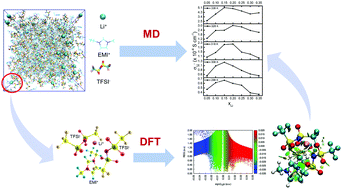Insights into the intermolecular interactions and temperature-concentration dependence of transport in ionic liquid-based EMI–TFSI/LiTFSI electrolytes†
Abstract
1-Ethyl-3-methylimidazolium bis(trifluoromethylsulfonyl)imide (EMI–TFSI) is one type of ionic liquid (IL) that has attracted much attention for its application as a lithium-ion battery electrolyte due to its large diffusion coefficient, wide temperature range of the liquid form, and high thermal stability. To gain insight into the performance of EMI–TFSI, the intermolecular interactions and temperature-concentration dependence of ion transport in EMI–TFSI/LiTFSI electrolytes were investigated using density functional theory (DFT) and molecular dynamics (MD). The DFT calculation results showed that a strong donor–acceptor interactions between the lone pair (LP) electrons of TFSI− and the lone vacant (LV) orbital of Li+ lead to a higher stabilization energy of the EMI–TFSI/LiTFSI system (88.47 kcal mol−1) compared to that of pure EMI–TFSI (48.52 kcal mol−1). The intermolecular interactions that occur among the ions consist of non-covalent and weak electrostatic interactions which are stabilized by a strong non-bonded attraction and steric interactions. The ionic transport properties calculated by MD simulations showed that the increase of Li+ ion concentration could decrease the diffusion coefficients and ionic conductivities of the system. Further analysis of the temperature–concentration dependence of EMI–TFSI/LiTFSI electrolyte transport showed that an optimum value of lithium-ion conductivity (σLi+) can be achieved using a moderate Li+ ion concentration (xLi) between 0.1 to 0.2, dependent on the temperature. In addition, we found that the highest lithium-ion conductivity (σLi+) at 298 K was 6.82 × 10−5 S cm−1 at xLi = 0.15, which increased to 5.15 × 10−4 S cm−1 at 338 K.



 Please wait while we load your content...
Please wait while we load your content...